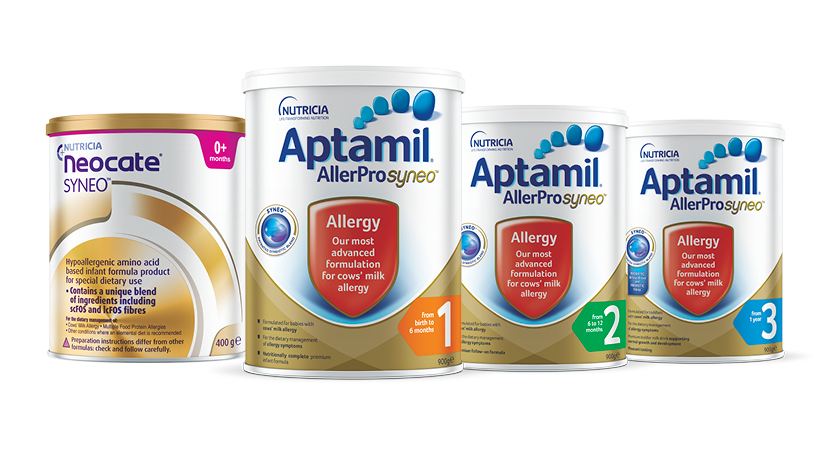Cow’s milk allergy (CMA) is a common food allergy, affecting around 2% (1 in 50) of infants across Australia and New Zealand.
CMA is often difficult to diagnose due to a similar presentation of symptoms to other health conditions. Understanding the signs of CMA is important for accurate, timely diagnosis and appropriate dietary management.
What is Cow’s Milk Allergy?
Cow’s milk allergy is when the immune system produces antibodies that detect the allergen (cow’s milk proteins). This causes an inflammatory reaction and the release of chemicals such as histamine, which causes allergic symptoms. People who are allergic to cow’s milk are most likely to also be allergic to goat, sheep, and buffalo milk. Cow’s milk allergy is different to lactose intolerance and guidelines should be followed for a correct diagnosis and appropriate management. Unnecessary and unsupervised exclusion of cow’s milk can have detrimental effects on the nutritional status of the child.
Who Does Cow’s Milk Allergy Affect?
The overall prevalence of allergic disease in Australia and New Zealand is on the rise. This includes food allergy, eczema, asthma, and allergic rhinitis (hay fever). Milk is a common cause of food allergy in babies and children, around 1-2% of preschool-aged children will be allergic. Most babies, around 80%, will outgrow milk allergy between the age of 3 – 5 years. As they get older these children should be monitored closely for the supervised reintroduction of cow’s milk.
Children with a family history of allergy (children with siblings or parents with food allergy or other allergic conditions) are more likely to develop a food allergy. However, infants with no family history can still develop allergies.
What Causes Cow’s Milk Allergy?
Cow’s milk allergy is an immune system reaction to a protein in cow’s milk. There is currently an increase in allergies in Australia and New Zealand. The cause of the increase in allergic disease is unknown, it is very complex and not well understood.
What are the different types of Cow’s Milk Allergy?
There are two types of allergic reactions that can present.
IgE-Mediated Cow’s Milk Allergy
IgE refers to a type of immune system blood cell called IgE. IgE-mediated cow’s milk allergy is a rapid reaction that occurs within 15 minutes – 2 hours after ingestion of cow’s milk or products that contain cow’s milk such as dairy products. Because it presents so quickly after consumption this type of reaction is much easier to diagnose.
Non IgE-Mediated Cow’s Milk Allergy
Non IgE mediated cow’s milk allergy is a delayed reaction that occurs several hours (usually 2 or more) after consuming cow’s milk or products that contain cow’s milk such as dairy products.
A confirmed diagnosis from a HCP is important to be able to manage food allergy safely following guidelines from the Australasian Society of Clinical Immunology and Allergy (ASCIA).
The Symptoms and Signs of CMA
Cow’s milk allergy can present differently for each individual but commonly affects one or more of the dermatological (skin), respiratory (breathing) and gastrointestinal (gut) systems. With such a wide range of symptoms, it can be difficult to diagnose however the likelihood of milk allergy increases in affected infants if symptoms appear in two of these systems.
Reactions are mostly mild to moderate however more severe reactions can occur.
Serious symptoms include difficulty breathing, swelling of the tongue, tightness of the throat, and going pale or floppy. Parents and caregivers should be educated on severe symptoms by a HCP and what to do if their child experiences them. This type of severe reaction occurs almost immediately after ingestion of cow’s milk and requires immediate attention for anaphylaxis.
Different signs and symptoms of cow’s milk allergy are explained below:
Dermatological
Dermatological symptoms affect the skin and are seen in up to 90% of cases of CMPA. Skin-related signs and symptoms include:
Eczema
Affects the skin and is commonly called atopic dermatitis. Eczema sometimes weeps and can cause a crust on the skin to develop. It can bleed or become infected.
Itching
Skin problems can cause itchy skin which can be uncomfortable. Histamine creates an urge to itch anywhere on the body and can be very irritating. Repeated itching can cause bleeding and can result in the skin becoming inflamed and infected.
Urticaria (Hives)
Irritated skin can become inflamed, bumpy, red, and slightly raised on the skin. This is called hives. The hives rash (skin rash) can last for a few minutes to hours and usually disappears within 24 hours. Chronic urticaria is when hives appear most days. One of the causes of hives is an allergic reaction. Hives that last for a few days at a time are rarely due to an allergy apart from a reaction to a specific medication.
Gastrointestinal
Gastrointestinal symptoms are present in the digestive system in up to 60% of cases of CMA children.
Digestive signs and symptoms include:
Blood in stools
When there is blood in the stool or poo, it is an indication that there is probably bleeding somewhere in the digestive tract. Parents or caregivers may notice that there’s some blood in the nappy.
Constipation
Constipation is difficulty passing a soft or hard lumpy stool accompanied by excessive straining. It can be very painful and can cause stomach pains, fidgeting to avoid passing a motion and the baby may be less hungry than normal.
Diarrhoea
Diarrhoea involves the passing of frequent, loose watery stools. Diarrhoea is typically short-lived and goes away without any treatment.
Vomiting
Vomiting is a common symptom of CMA. Vomiting involves forcefully expelling the contents of the stomach out of the mouth. This can cause minor infant feeding issues and can be very upsetting.
Reflux
Reflux is when the contents of the stomach come back up the oesophagus or into the mouth. Infants with severe reflux commonly present with difficulty feeding, poor weight gain and extreme irritability which may be related to an allergy to milk protein.
The Symptoms and Signs of CMA
Cow’s milk allergy can present differently for each individual but commonly affects one or more of the dermatological (skin), respiratory (breathing) and gastrointestinal (gut) systems. With such a wide range of symptoms, it can be difficult to diagnose however the likelihood of milk allergy increases in affected infants if symptoms appear in two of these systems.
Reactions are mostly mild to moderate however more severe reactions can occur.
Serious symptoms include difficulty breathing, swelling of the tongue, tightness of the throat, and going pale or floppy. Parents and caregivers should be educated on severe symptoms by a HCP and what to do if their child experiences them. This type of severe reaction occurs almost immediately after ingestion of cow’s milk and requires immediate attention for anaphylaxis.
Lactose intolerance or Cow’s Milk Allergy (CMA)?
Gastrointestinal symptoms from cow’s milk are more likely due to an allergic reaction to milk proteins rather than intolerance to lactose.
When diagnosing lactose intolerance or CMA, careful consideration should be given to the child’s history, especially their allergy-focused history. In babies or young children, secondary lactose intolerance is the most common form of lactose intolerance and is a transient condition usually due to an injury to the gastrointestinal tract.

Lactose intolerance or cows’ milk allergy (CMA)?
- Gastrointestinal symptoms from cows’ milk are more likely due to an allergic reaction to milk proteins rather than an intolerance to lactose.2
- When considering lactose intolerance or CMA, careful consideration should be given to the presenting symptoms – lactose intolerance does not involve an immune reaction.<sup1–3
9 out of 10 infants with CMA will present with two or more of the following symptoms:2–5

Dermatological

Gastrointestinal

Respiratory

5 common misconceptions of cows’ milk allergy
What should healthcare practitioners be looking out for when considering CMPA and what are common misconceptions?
Hear from real parents about their CMA diagnosis journey
Useful resources

Diagnostic and treatment algorithms

CPD education modules

Practical guide to CMA diagnosis

Discover how the SYNEO™ range from Nutricia could make a difference to your patients with CMPA
A deeper understanding of the role of the gut microbiome in health and disease is changing how we think about and treat cows’ milk protein allergy (CMA).
Related articles

Gut dysbiosis and cows’ milk allergy (CMA) — is there a link?

Inside the tin: a guide to infant formula for the management of cows’ milk allergy (CMA)

A unique prebiotic blend that supports healthy immune development
Support for you and your patients
Join now and learn about our education events, research initiatives and evidence-based resources – furthering your professional development and clinical practice.
References:
1. ASCIA. Cow’s Milk (Dairy) Allergy 2019. Available at: www.allergy.org.au/patients/food-allergy/cows-milk-dairy-allergy (accessed August 2021).
2. Venter C. Cow’s Milk Allergy: myth v reality. Available at: www.nutricia.co.uk/hcp/resource-centre/cows-milk-allergy-myth-v-reality.html (accessed August 2021).
3. Walsh J et al. Br J Gen Pract 2016;66(649):e609–11.
4. Fiocchi A et al. WAO Journal 2010; 57–161.
5. Host A and Halken S. Allergy 1990;45:587–96.
